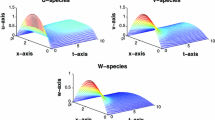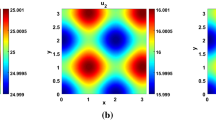Abstract
In this paper, we develop a theoretical framework for a research into spatial patterns in a three-species Holling II and Leslie-Gower type food chain model with cross-diffusion, the results of which show that the cross-diffusion induces the spatial patterns. When biological pattern formation has been concerned with the method of reaction-diffusion theory, in most of the previous works, as a precondition, the assumption of the existence of nonhomogeneous steady state is presented essentially. We give a rigorous proof to the assumption that the model has at least a nonhomogeneous stationary solution by the Leray-Schauder degree theory. Moreover, the numerical simulations for spatial pattern is also carried out, we propose a method to estimate the wavenumber of the spatial patterns.
Similar content being viewed by others
References
Turing A.: The chemical basis of morphogenesis. Philos. Trans. R. Soc. B 237, 37–72 (1952)
Noszticzius Z., Horsthemke W., McCormick W.D., Swinney H.L., Tam W.Y.: Sustained chemical waves in an annular gel reactor: A chemical pinwheel. Nature 329, 619–620 (1987)
Tam W.Y., Horsthemke W., Noszticzius Z., Swinney H.L.: Sustained spiral waves in a continuously fed unstirred chemical reactor. J. Chem. Phys. 88, 3395–3396 (1988)
Ouyang Q., Noszticzius Z., Swinney H.L.: Spatial bistability of two-dimensional Turing patterns in a reaction-diffusion system. J. Phys. Chem. 96, 6773–6776 (1992)
Castets V., Dulos E., Boissonade J., De Kepper P.: Experimental evidence of a sustained standing Turing-type nonequilibrium chemical pattern. Phys. Rev. Lett. 64, 2953–2956 (1990)
De Kepper P., Castets V., Dulos E., Boissonade J.: Turing-type chemical patterns in the chlorite-iodide-malonic acid reaction. Phys. D 49, 161–169 (1991)
Maini P.K., Painter K.J., Phong C.H.N.: Spatial pattern formation in chemical and biological system. J. Chem. Soc. Faraday Trans. 93, 3601–3610 (1997)
Maini P.K., Benson D.L., Sherratt J.A.: Pattern formation in reaction diffusion models with spatially inhomogeneous diffusion coefficients. IMA J. Math. Appl. Med. Biol. 9, 197–213 (1992)
Crampin E.J., Gaffney E., Maini P.K.: Reaction and diffusion growing domains: Scenarios for robust pattern formation. Bull. Math. Biol. 61, 1093–1120 (1999)
Painter K.J., Maini P.K., Othmer H.G.: Development and applications of a model for cellular response to multiple chemotactic cues. J. Math. Biol. 41, 285–314 (2000)
Satnoianu R.A., Menzinger M., Maini P.K.: Turing instabilities in general systems. J. Math. Biol. 41, 493–512 (2000)
Crampin E.J., Gaffney E., Maini P.K.: Mode-doubling and tripling in reaction-diffusion patterns on growing domains: a piecewise linear model. J. Math. Biol. 44, 107–128 (2002)
Crampin E.J., Hackborn W.W., Maini P.K.: Pattern formation in reaction-diffusion models with nonuniform domain growth. Bull. Math. Biol. 64, 746–769 (2002)
Miura T., Maini P.K.: Speed of pattern appearance in reaction-diffusion models: implications in the pattern formation of limb bud mesenchyme cells. Bull. Math. Biol. 66, 627–649 (2004)
Baker R.E., Maini P.K.: A mechanism for morphogen-controlled domain growth. J. Math. Biol. 54, 597–622 (2007)
Murray J.D.: Mathematical Biology of Biomathematics Texts, Vol. 19, 2nd edn. Springer, Berlin (2002)
Turanyi T.: Sensitivity analysis of complex kinetic systems: Tools and applications. J. Math. Chem. 5, 203–248 (1990)
O.M. Daher, M.A. Aziz-Alaoui, On the dynamics of a predator-prey model with the Holling-Tanner functional response, MIRIAM Editions, Editor V. Capasso, Proc. ESMTB conf. pp. 270–278 (2002)
Kareiva P., Odell G.: Swarms of preadatora exhibit “preytaxis” if individual predators use area-restricted. Search. Am. Nat. 130, 233–270 (1987)
Kuto K.: Stability of steady-state solutions to a prey-predator system with cross-diffusion. J. Differ. Equ. 197, 293–314 (2004)
Kuto K., Yamada Y.: Multiple coexistence states for a prey-predator system with cross-diffusion. J. Differ. Equ. 197, 315–348 (2004)
Lin Z.G.: A time delayed parabolic system in a three-species predator-prey model. Acta Math. Sin. (Chin. Ser.) 47, 559–568 (2004)
Lin Z.G., Pedersen M.: Stability in a diffusive food-chain model with Michaelis-Menten functional response. Nonlinear Anal. 57, 421–433 (2004)
Rai B., Freedman H.I., Addicott J.F.: Analysis of three-species models of mutualism in predator-prey and competitive systems. Math. Biosci. 65(1), 13–50 (1983)
Aziz-Alaoui M.A., Daher Okiye M.: Boundedness and global stability for a predator-prey model with modified Leslie-Gower and Holling-type II schemes. Appl. Math. Lett. 16, 1069–1075 (2003)
Nindjin A.F., Aziz-Alaoui M.A.: Persistence and global stability in a delayed Leslie-Gower-type three species food chain. J. Math. Anal. Appl. 340, 340–357 (2008)
Pang P.Y.H., Wang M.X.: Strategy and stationary pattern in a three-species predator-prey model. J. Differ. Equ. 200, 245–273 (2004)
Chen W., Peng R.: Stationary patterns created by cross-diffusion for the competitor-competitor-mutualist model. J. Math. Anal. Appl. 291, 550–564 (2004)
Wang M.: Stationary patterns for a prey-predator model with prey-dependent and ratio-dependent functional responses and diffusion. Phys. D 196, 172–192 (2004)
Wang M.: Stationary patterns caused by cross-diffusion for a three -species prey-predator model. Comput. Math. Appl. 52, 707–720 (2006)
Peng R., Wang M., Yang G.: Stationary patterns of the Holling-Tanner prey-predator model with diffusion and cross-diffusion. Appl. Math. Comput. 196, 570–577 (2008)
Barrio R.A., Varea C., Aragón J.L.: A two-dimensional numerical study of spatial pattern formation in interating Turing systems. Bull. Math. Biol. 61, 483–505 (1999)
Barrio R.A., Varea C.: Non-linear systems. Phys. A 372, 210–223 (2006)
Varea C., Aragón J.L., Barrio R.A.: Turing patterns on a sphere. Phys. Rev. E 60, 4588–4592 (1999)
Ko W., Ahn I.: Analysis of ratio-dependent food chain model. J. Math. Anal. Appl. 339, 498–523 (2007)
Henry D.: Geometric Theory of Semilinear Parabolic Equations, Lecture Notes in Mathematics 840. Springer, Berlin (1993)
Lin C.S., Ni W.M., Takagi I.: Large amplitude stationary solutions to a chemotaxis systems. J. Differ. Equ. 72, 1–27 (1988)
Lou Y., Ni W.M.: Diffusion, self-diffusion and cross-diffusion. J. Differ. Equ. 131, 79–131 (1996)
Nirenberg L.: Topics in Nonlinear Functional Analysiss. American Mathematical Society, Providence, RI (2001)
Author information
Authors and Affiliations
Corresponding author
Additional information
The work is partially supported by PRC grant NSFC 10801115.
Rights and permissions
About this article
Cite this article
Tian, C. Turing patterns created by cross-diffusion for a Holling II and Leslie-Gower type three species food chain model. J Math Chem 49, 1128–1150 (2011). https://doi.org/10.1007/s10910-011-9801-z
Received:
Accepted:
Published:
Issue Date:
DOI: https://doi.org/10.1007/s10910-011-9801-z




